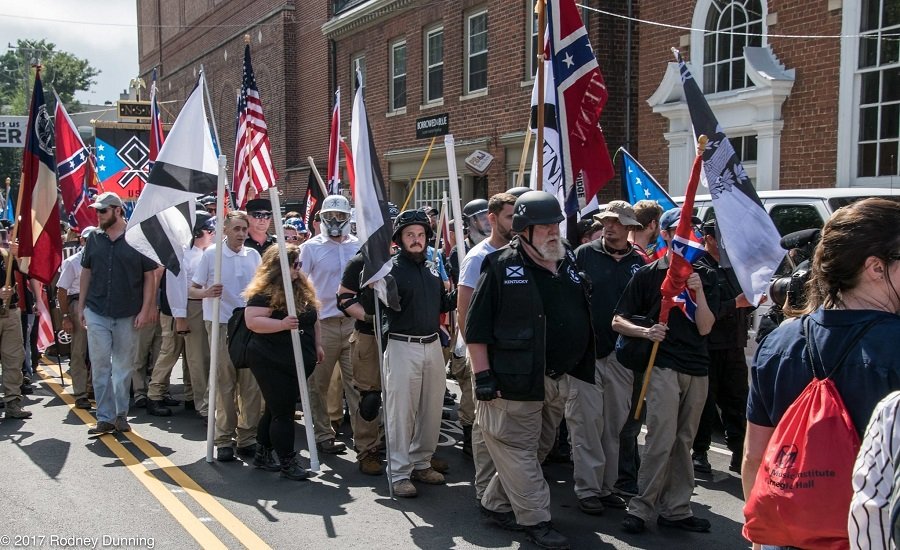The most recent draft report predicts an “elevated threat environment at least through” early next year, concluding that some of the US-based violent extremists have capitalised on increased social and political tensions in 2020. It says although foreign terrorist organisations will continue to call for attacks on the US, they “probably will remain constrained in their ability to direct such plots over the next year.”
The threat assessment — which also warns of continued disinformation efforts by Russia — is especially notable as President Donald Trump has often used race-baiting tactics in his quest for reelection and frequently downplayed the threat from white supremacists during his term in office. The Trump administration has portrayed Antifa and anarchists as a top threat to the US, with the President tweeting this summer that the US will designate Antifa as a terrorist organization.
In the two latter drafts the language was changed and “white supremacist extremists” were replaced with “domestic violent extremists”, but the reality is that white supremacist extremism has become one of the most “potent ideologies” behind acts of violence in the US.
It is no secret that President Trump’s first term has seen a sharp rise in the white supremacist movement and organisations with whom he has openly flirted with and never condemned the racist violence, especially the police brutality against Afro-Americans.
The Anti-Defamation League reported that acts of white supremacist propaganda almost tripled from 2017 to 2018, jumping from 428 to 1,214 cases. Last year, the acts more than doubled to 2,713. White supremacists advertise their support of white dominance by distributing leaflets, stickers, banners and posters around the country. Their most common target is college campuses.
The US think tank, Center for Strategic and International Studies (CSIS), in its report “The escalating terrorism problem in the United States” says the far-right terrorism has significantly outpaced terrorism from other types of perpetrators, including from far-left networks and individuals inspired by the Islamic State and al-Qaeda.
Right-wing attacks and plots account for the majority of all terrorist incidents in the United States since 1994, and the total number of right-wing attacks and plots has grown significantly during the past six years. Right-wing extremists perpetrated two-thirds of the attacks and plots in the United States in 2019 and over 90 per cent between January 1 and May 8, 2020.
It says terrorism in the United States will probably increase over the next year in response to several factors, including presidential election and Covid-19.
The CSIS report says the November 2020 presidential election will probably be a significant source of anger and polarisation that increases the possibility of terrorism. Some far-right extremists who associate themselves with President Trump may resort to violence before or after the election.
As US Department of Justice documents have highlighted that some far-right extremists, who call themselves “Trumpenkriegers”—or “fighters for Trump may turn violent if Trump loses the election because they believe—however incorrectly, that there was fraud or that the election of Democratic candidate Joe Biden will undermine their extremist objectives.
On Covid-19 crisis, the CSIS report says prolonged unemployment or government attempts to close “non-essential” businesses in response to a second or third wave—could increase the possibility of terrorism. Some far-right extremists, for example, have threatened violence and railed against federal, state, and local efforts to take away their freedoms by requiring face masks in public indoor settings, closing businesses, and prohibiting large gatherings to curb the spread of the virus.
The home-grown right-wing extremism has spread with such fast speed that it has overshadowed the threat posed by jihadi-inspired terrorists. Experts say the layered set of defence and security measures has reduced the threat so much that except for the attack at the Naval Air Station Pensacola on December 6, 2019, the US has not seen an act of terrorism by foreign terrorist organisations like al-Qaeda or ISIS in 19 years since 9/11 happened.
The white supremacist groups have become so emboldened that FBI Director Christopher Wray recently told a House Judiciary Committee hearing that he has “elevated racially motivated violent extremism as a national threat priority for fiscal year ’20, which puts it on the same footing as ISIS and our homegrown violent extremists.”
c. The Brussels Times

